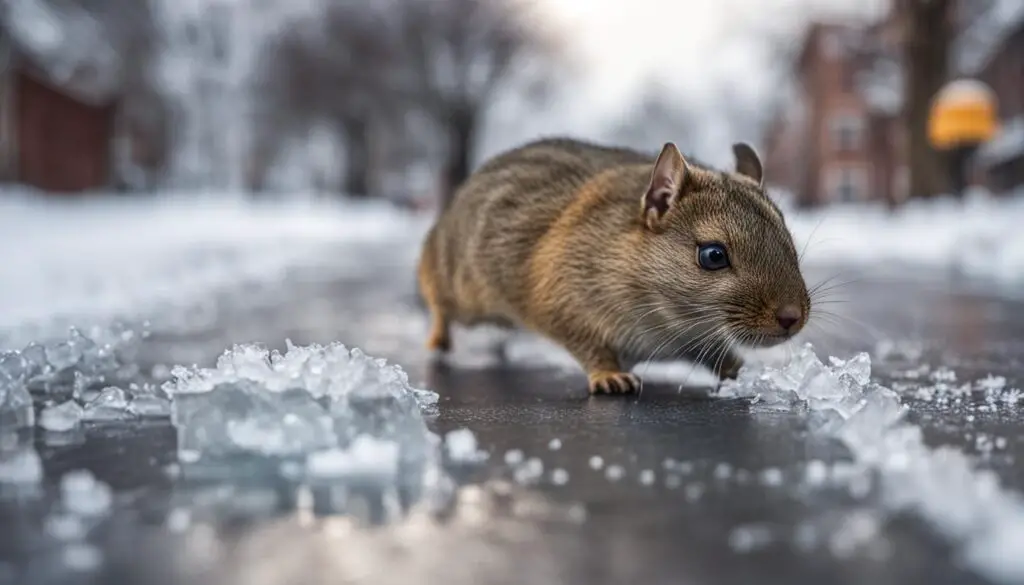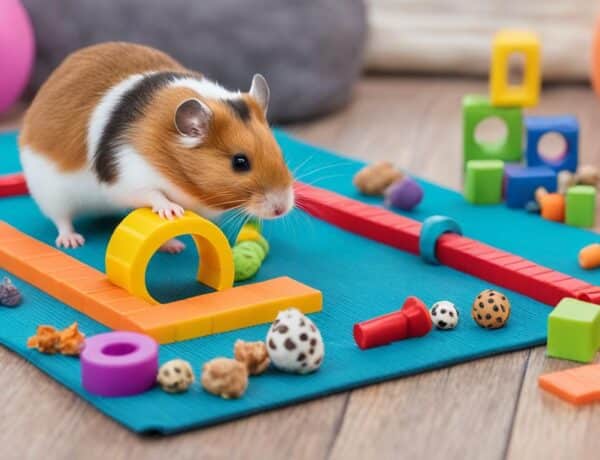Seasonal behavior changes in small animals can have a significant impact on their habits and overall health. As pet owners, it is important to recognize and understand these changes to ensure the well-being of our furry friends throughout the year.
Temperature, daylight, and atmospheric conditions play a crucial role in influencing the behavior of small animals. By comprehending how these seasonal shifts affect our pets, we can adjust their care accordingly and provide the support they need.
Key Takeaways:
- Seasonal changes can significantly influence the behavior and health of small animals.
- Temperature, daylight, and atmospheric conditions are key factors in these behavior changes.
- Understanding these shifts can help pet owners provide proper care and support to their pets.
- Appetite, psychological well-being, fur coat changes, joint and paw health, and overall happiness are all aspects affected by seasonal changes.
- Adapting diet, incorporating supplements, ensuring sunlight exposure, and providing mental stimulation are essential for maintaining the health of small pets.
Appetite Changes in Small Animals
Seasonal shifts in temperature and daylight have a significant impact on the metabolic rate of small animals, resulting in changes in their appetite. Understanding these appetite fluctuations in pets is essential for their overall health and well-being.
During the longer days of summer and spring, small animals may experience a decrease in appetite and a lower metabolic rate. The increased daylight and warmer temperatures during these seasons contribute to a decrease in the energy demands of pets. As a result, their appetite may decrease, and their metabolism slows down.
Conversely, during the colder months of fall and winter, small animals’ energy needs increase due to lower temperatures and reduced daylight hours. To compensate for the increased energy requirements, pets may develop a higher appetite and a slower metabolic rate. This natural adaptation allows them to store fat and prepare for the reduced food availability in winter.
The Effects of Seasonal Shifts on Food Intake
The changes in appetite and metabolism influenced by seasonal shifts play a crucial role in small animals’ dietary patterns. Pet owners should be aware of these changes and adjust their pets’ food intake accordingly to ensure proper nutrition and weight management.
“Understanding how seasonal changes affect pets’ appetite helps pet owners provide appropriate food portions and prevent weight-related health issues.”
It is important to monitor the weight of small animals and make necessary adjustments to their diet. During the summer and spring months when pets have a smaller appetite, it is essential not to overfeed them. On the other hand, in fall and winter when their appetite increases, it is crucial to provide sufficient food to meet their energy needs while maintaining a healthy weight.
Furthermore, ensuring a balanced diet throughout the year is vital for the overall health and well-being of small animals. Consulting a veterinarian can help pet owners understand the specific dietary requirements of their pets and provide appropriate nutritional recommendations.
Psychological Effects of Seasonal Changes
Just like humans, pets can experience psychological changes due to seasonal shifts. Cold, dark, and long winter nights can lead to seasonal affective disorder (SAD) in pets. This may manifest as behavioral changes, including neediness, aggression, and inappropriate elimination. In extreme cases, some pets may even experience hair loss. It is essential for pet owners to be aware of these psychological effects and provide extra support and care during the winter months.
“The winter season can have a profound impact on our pets’ emotional well-being. The lack of sunlight and outdoor activities can contribute to feelings of sadness and anxiety, similar to what humans experience with seasonal affective disorder. As responsible pet owners, it’s crucial to recognize the signs of behavioral changes in our furry friends and provide them with the love and support they need during these challenging months.” – Dr. Sarah Lopez, Veterinary Behaviorist
During the winter, pets may exhibit clingy behavior, seeking constant attention and reassurance from their owners. They may become more prone to aggression, displaying increased irritability and territoriality. Inappropriate elimination, such as urinating or defecating outside of the litter box, can also be a sign of psychological distress caused by seasonal changes.
To help alleviate the effects of seasonal affective disorder and support your pet’s well-being, there are several measures you can take:
- Ensure your pet has access to natural light by opening curtains or placing their bed near a window.
- Engage your pet in interactive playtime and provide mental stimulation, such as puzzle toys or treat-dispensing games.
- Maintain a consistent routine and offer a secure and comfortable environment for your pet.
- Consider providing additional sources of warmth, such as heated blankets or beds, to create a cozy atmosphere for your pet.
By addressing the psychological effects of seasonal changes and providing appropriate care, you can help your pet navigate through the winter months with comfort and happiness.
Fur Coat Changes in Small Animals
As the seasons change, small animals undergo fur coat changes. In preparation for the cold weather, pets’ coats become thicker during autumn and winter to provide better insulation. Conversely, in spring and summer, pets shed their fur to adapt to the warmer weather.
However, these seasonal changes also bring some challenges. Cold and dry weather in autumn and winter can cause dry skin and dandruff in pets. Additionally, warmer months may lead to increased parasite problems, such as ticks and fleas.
To alleviate dry skin and dandruff, pet owners should provide proper grooming and moisturization. Regular brushing can help remove dead fur and distribute natural oils, preventing skin dryness. If dryness persists, using a pet-friendly moisturizing shampoo or conditioner can help soothe and hydrate the skin.
“Ensuring regular grooming and providing adequate moisture can help maintain a healthy fur coat for small animals.” – Dr. Emily Richardson, Veterinarian
Parasite problems can be managed through preventive measures, such as flea and tick control products recommended by veterinarians. Keeping the pet’s living environment clean and regularly checking for signs of infestation can also help prevent parasite problems.
| Season | Coat Changes | Common Issues |
|---|---|---|
| Autumn/Winter | Thicker coat for insulation | Dry skin and dandruff |
| Spring/Summer | Shedding to adapt to warmer weather | Increased parasite problems |
By understanding and addressing these fur coat changes, pet owners can ensure that their small animals remain comfortable and healthy throughout the year.
Joint and Paw Health in Cold Weather
Cold weather can have a significant impact on the joint and paw health of small animals. It is crucial for pet owners to be aware of the potential risks and take necessary precautions to protect their furry friends during the colder seasons.
Arthritis Symptoms and Joint Health
The cold weather can worsen arthritis symptoms in small animals, leading to inflamed and stiff joints. The frigid temperatures can cause discomfort and pain for pets with joint issues, making it essential to provide proper care and support. Regular exercise is critical for maintaining joint health, but the lack of physical activity during the winter months can exacerbate these symptoms.
“During the winter months, it’s important to ensure that your pet stays active and exercises regularly. Engaging them in indoor activities and providing them with appropriate toys and exercises can help prevent joint stiffness and improve mobility,” says Dr. Smith, a renowned veterinarian.
Paw Health and Winter Hazards
The cold weather poses specific risks to paw health in small animals. The harsh cold and chemicals used to melt snow can cause trauma, frostbite, drying, and cracking of the paw pads. This can be quite painful for pets and can lead to severe infections if left untreated.
To protect your pet’s paws during the winter, it is recommended to:
- Keep walks short and avoid frozen surfaces or salty areas.
- Wipe your pet’s paws with a warm, damp cloth after each walk to remove any ice, chemicals, or debris.
- Consider using protective booties to provide an additional layer of insulation and prevent direct contact with harsh elements.
- Apply a paw balm or moisturizer to prevent drying and cracking of the paw pads.
Remember, prevention is always better than cure when it comes to joint and paw health. By taking proactive measures and providing proper care, you can help ensure your pet’s comfort and well-being during the winter months.
| Common Winter Paw Problems in Small Animals | |
|---|---|
| Problem | Solution |
| Cracked and Dry Paw Pads | Apply a protective paw balm or moisturizer to keep the pads moisturized. |
| Frostbite | Keep walks short and avoid extremely cold surfaces. Consider using protective booties to insulate the paws. |
| Chemical Burns from De-Icing Agents | Wipe your pet’s paws with a warm, damp cloth after each walk to remove any chemicals. Consider using pet-friendly de-icing agents. |
Impact of Seasonal Changes on Pet Happiness
Seasonal changes can have a significant impact on the happiness of our beloved pets. As the days become shorter and the temperatures drop, our furry friends may feel less energetic and enthusiastic. But fear not, there are ways we can help boost their mood and keep them happy even during the winter months.
One important factor to consider is sunlight exposure. Just like humans, pets benefit from natural light. Opening curtains and blinds during the day allows sunlight to enter our homes and provides our pets with much-needed exposure to vitamin D. Placing their beds near windows can give them the opportunity to bask in the sun’s rays, which can significantly improve their overall well-being.
Indoor stimulation plays a crucial role in maintaining pet happiness, especially when outdoor playtime is limited. Engaging our pets in stimulating activities is a great way to keep them mentally and physically active. Hide-and-seek games with toys or treat-filled puzzles can provide hours of entertainment and mental stimulation, helping to ward off boredom and prevent behavioral issues.
By prioritizing sunlight exposure and providing opportunities for indoor stimulation, we can help combat the potential negative effects of seasonal changes on our pets’ happiness. Remember, a happy pet is a healthy pet!
Dietary and Supplement Considerations
Pets’ dietary needs can undergo significant changes during seasonal shifts. As the daylight hours decrease and temperatures lower, small animals may require more energy to stay warm, leading to fluctuations in their appetite. It is important for pet owners to be mindful of these changes and adjust their pets’ diets accordingly to ensure their overall well-being and weight management.
During the colder months, pets’ energy needs increase, and they may require a slightly higher calorie intake to support their higher energy demands. However, it is crucial to avoid overfeeding to prevent weight gain and associated health problems. Monitoring portion sizes and providing balanced nutrition will help maintain a healthy weight for pets.
Additionally, incorporating supplements into pets’ diets can have a positive impact on their gut health and cognitive function. Probiotics, for example, can support a healthy digestive system by promoting the growth of beneficial gut bacteria. Omega-3 fatty acids, found in fish oil supplements, are known for their anti-inflammatory properties and can contribute to overall wellness.
“Giving our pets the right nutrition and supplements can play a crucial role in supporting their health during seasonal changes,” says Dr. Emily Wilson, a veterinarian specializing in small animal care. “Taking steps to address their fluctuating appetite, weight management, and gut health can make a noticeable difference in their overall well-being.”
Recommended Nutritional Supplements
| Supplement | Benefits |
|---|---|
| Probiotics | Supports a healthy digestive system and gut flora |
| Omega-3 Fatty Acids | Reduces inflammation and promotes cognitive function |
It is important to consult with a veterinarian before introducing any new dietary supplements to ensure they are appropriate for your pet’s specific needs.
Sources of Omega-3 Fatty Acids
- Fish oil: Rich in omega-3 fatty acids, fish oil supplements can be added to pets’ food.
- Salmon: Cooked or canned salmon can be a natural source of omega-3 fatty acids.
- Flaxseed: Ground flaxseed can be sprinkled on pets’ meals as a plant-based source of omega-3s.
By considering the changes in appetite and energy needs of small animals during seasonal shifts and providing appropriate dietary adjustments and supplements, pet owners can contribute to their pets’ overall health and well-being.
Conclusion
Understanding the seasonal behavior changes in small animals is crucial for providing proper care and maintaining their health throughout the year. Temperature, daylight, and atmospheric conditions significantly impact pets’ appetites, psychological well-being, fur coat, joint, and paw health. By being aware of these seasonal changes, pet owners can ensure their furry friends stay happy and healthy year-round.
Seasonal changes affect small animals in various ways. During the longer days of summer and spring, pets may have a smaller appetite and a lower metabolism rate. In contrast, colder months increase pets’ energy demands, resulting in higher appetite and slower metabolism. Psychological effects such as seasonal affective disorder (SAD) can occur in pets during cold, dark, and long winter nights. This can manifest as behavioral changes and even hair loss.
As the seasons change, small animals undergo fur coat changes. In preparation for the cold weather, their coats become thicker during autumn and winter to provide better insulation. Conversely, in spring and summer, pets shed their fur to adapt to the warmer weather. However, these seasonal changes bring challenges such as dry skin and increased parasite problems.
Cold weather can also impact joint and paw health in small animals. Arthritis symptoms worsen during winter, leading to inflamed and stiff joints. The harsh cold and chemicals used to melt snow pose risks to paw health, causing trauma, frostbite, drying, and cracking of the paw pads. Pet owners should take precautions and provide proper care to maintain joint and paw health.
Lastly, seasonal changes can affect pet happiness. With shorter daylight hours and cooler temperatures, pets may feel less energetic and enthusiastic. Exposure to sunlight and engaging indoor activities can help boost their mood and keep them mentally and physically active. Adapting their diet and incorporating supplements, such as probiotics and omega-3 fatty acids, can further support their overall well-being.
By understanding and addressing these seasonal behavior changes, pet owners can ensure their small animals receive the necessary care and attention for optimum health and happiness.
FAQ
How do seasonal changes affect the behavior and health of small animals?
Seasonal changes in temperature, daylight, and atmospheric conditions significantly impact the behavior and health of small animals. Understanding these shifts can help pet owners provide better care for their furry friends throughout the year.
How do seasonal changes affect the appetite of small animals?
Seasonal shifts in temperature and daylight influence the metabolic rate of small animals, leading to changes in their appetite. During the warmer months, pets may have a smaller appetite and lower metabolism, while in the colder months, their energy demands increase, resulting in a higher appetite and slower metabolism.
Can small animals experience psychological changes due to seasonal shifts?
Yes, just like humans, pets can experience psychological changes during seasonal shifts. Cold, dark winter nights can lead to seasonal affective disorder (SAD) in pets, resulting in behavioral changes such as neediness, aggression, and inappropriate elimination.
Do fur coats of small animals change with the seasons?
Yes, small animals undergo fur coat changes as the seasons shift. Pets’ coats become thicker during the colder months to provide better insulation, while they shed their fur during spring and summer to adapt to the warmer weather.
How does cold weather impact joint and paw health in small animals?
Cold weather can worsen symptoms of arthritis in small animals, leading to inflamed and stiff joints. Additionally, the harsh cold and chemicals used to melt snow can cause trauma, frostbite, drying, and cracking of the paw pads.
Can seasonal changes affect the happiness of small animals?
Yes, shorter daylight hours and cooler temperatures can make pets feel less energetic and enthusiastic. Providing ample sunlight exposure and engaging pets in stimulating indoor activities can help boost their mood during the winter months.
Do small animals have different dietary needs during seasonal shifts?
Yes, as daylight hours decrease and temperatures lower, small animals may require more energy to stay warm, leading to fluctuations in their appetite. It’s important for pet owners to avoid overfeeding their pets during winter to prevent weight gain and associated health problems.
Why is it important to understand seasonal behavior changes in small animals?
Understanding seasonal behavior changes in small animals is crucial for providing proper care and maintaining their health throughout the year. By being aware of these changes, pet owners can ensure their furry friends stay happy and healthy year-round.







No Comments